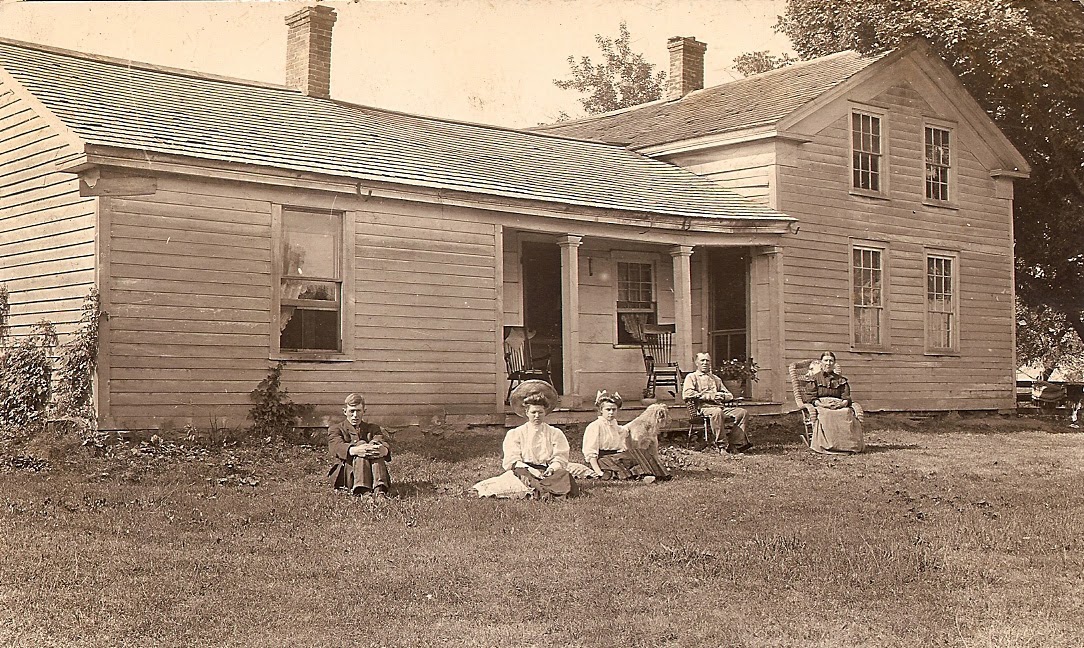A recent book by Fred Peterson titled Homes in the Heartland describes the evolution of the balloon-frame farmhouse in the upper Midwest. Peterson notes one characteristic of many, first generation farmhouses: an eclectic nature where they were built in stages with several additions.
When settlers arrived in the Midwest one of their first priorities was building shelter. This might be a log cabin or a small, hastily built frame house. As the family established themselves in their new home, earned some money and had more children, the original home rapidly became insufficient. Some abandoned their old log home and used it as a barn or shed. Others built additions onto their simple home and added fashionable Greek Revival or Victorian ornament to display the family’s growing prosperity. Indeed, many Midwestern log cabins and first-generation claim shacks survive to this day cocooned within clapboard siding or surrounded by later additions.
This presents us with many opportunities to play “house detective” and try to determine the history of a building. Consider this example: A Greek Revival farmhouse built somewhere in Michigan. Take a look at the photo below and try to be a house detective yourself. How many additions do you see? Which section is the oldest? In what order were they built? See what you can figure out and then continue reading to see if you agree with me
I can identify three different sections: 1) the story-and-a-half, Greek Revival house on the right 2) A middle section with wide siding 3) The section to the left with narrow clapboard siding.
Which section is the oldest? It it impossible to say with absolute certainty, but I believe the section to the right is the oldest. The Greek Revival was an early building style popular during the middle of the 19th century, suggesting it was likely built first around the time of the Civil War. The multi-paned, nine-over-six window glazing is characteristic of the style as are the the eave returns and frieze boards. This section most certainly has a centrally located side entrance with a three or four room floor plan. The entrance door we see on the corner is certainly a later addition, as this would be a very unusual arrangement on a Greek Revival style home.
Most often the first addition to a simple farmhouse was a kitchen as it allowed the family to remove the heat from the wood stove and cooking odors from the main part of the house. These additions frequently included a small pantry or an additional bedroom. In this case the kitchen addition is the middle section. We find many Midwestern and Northeastern farmhouses configured this way and they are called an upright-and-wing or a gable-and-wing. Although some were built this way at the beginning many, like this example, were built in stages.
How do I know that the house wasn’t built this way originally? Because of the kitchen’s wide siding. Although the builder added some Greek Revival style molding along the eaves with decorative posts on the wash porch, the wide siding suggests it was built at a different time. Furthermore, since there is bit of the wide siding on the story-and-a-half section, this suggests that original, narrow clapboards were removed when the kitchen addition was built. When the new entrance door was added at the right corner they used the new kitchen siding on the older section of the house. The original, centrally located entrance door likely became the interior door leading to the kitchen addition. Since the kitchen window is also multi-paned, this time six-over-six, I suspect the kitchen was added fairly early in the house’s history.
We are left with the section to the left. It is distinct from the kitchen addition due to the narrow, clapboard siding. Although the builder again continued the band of molding across the front and added eave returns, the plain, one-over-one window glazing suggests this could be a later addition, perhaps from the 1880s or later. Although it is possible that the window is a replacement of an original, the very simple casing around it suggests a later date. Another possibility is that is section was actually another, older building which was moved in and attached with newer style windows installed. Only a close examination could tell us for sure.
There are other ways to date additions, although they are difficult with photographs such as this. Square nails were commonly used until 1880s when wire nails (also called French nails) became prevalent. Another easy way is to look at the foundation. Early foundations were often made from rubble stone found in the fields. By examining the type of stones, blocks, brick and mortar you can often identify the order in which additions were built.
So, how did I do? Do you agree with me? If not, post a comment and let me know!
The next time you are driving about in the country, look around and see if you can identify an early farmhouse. Then try your hand at house detective and discover a bit of a family’s history.



0 Comments